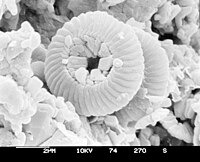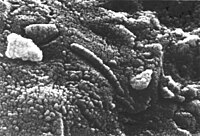A biosignature (sometimes called chemical fossil or molecular fossil) is any substance – such as an element, isotope, molecule, or phenomenon – that provides scientific evidence of past or present life. Measurable attributes of life include its complex physical and chemical structures and also its utilization of free energy and the production of biomass and wastes. Due to its unique characteristics, a biosignature can be interpreted as having been produced by living organisms; however, it is important that they not be considered definitive because there is no way of knowing in advance which ones are universal to life and which ones are unique to the peculiar circumstances of life on Earth. Nonetheless, life forms are known to shed unique chemicals, including DNA, into the environment as evidence of their presence in a particular location.
In geomicrobiology
-4500 —
–
-4000 —
–
-3500 —
–
-3000 —
–
-2500 —
–
-2000 —
–
-1500 —
–
-1000 —
–
-500 —
–
0 —
Electron micrograph of microfossils from a sediment core obtained by the Deep Sea Drilling Program
The ancient record on Earth provides an opportunity to see what geochemical signatures are produced by microbial life and how these signatures are preserved over geologic time. Some related disciplines such as geochemistry, geobiology, and geomicrobiology often use biosignatures to determine if living organisms are or were present in a sample. These possible biosignatures include: (a) microfossils and stromatolites; (b) molecular structures (biomarkers) and isotopic compositions of carbon, nitrogen and hydrogen in organic matter; (c) multiple sulfur and oxygen isotope ratios of minerals; and (d) abundance relationships and isotopic compositions of redox sensitive metals (e.g., Fe, Mo, Cr, and rare earth elements).
For example, the particular fatty acids measured in a sample can indicate which types of bacteria and archaea live in that environment. Another example are the long-chain fatty alcohols with more than 23 atoms that are produced by planktonic bacteria. When used in this sense, geochemists often prefer the term biomarker. Another example is the presence of straight-chain lipids in the form of alkanes, alcohols an fatty acids with 20-36 carbon atoms in soils or sediments. Peat deposits are an indication of originating from the epicuticular wax of higher plants.
Life processes may produce a range of biosignatures such as nucleic acids, lipids, proteins, amino acids, kerogen-like material and various morphological features that are detectable in rocks and sediments. Microbes often interact with geochemical processes, leaving features in the rock record indicative of biosignatures. For example, bacterial micrometer-sized pores in carbonate rocks resemble inclusions under transmitted light, but have distinct size, shapes and patterns (swirling or dendritic) and are distributed differently from common fluid inclusions. A potential biosignature is a phenomenon that may have been produced by life, but for which alternate abiotic origins may also be possible.
In astrobiology
Astrobiological exploration is founded upon the premise that biosignatures encountered in space will be recognizable as extraterrestrial life. The usefulness of a biosignature is determined, not only by the probability of life creating it, but also by the improbability of nonbiological (abiotic) processes producing it. Concluding that evidence of an extraterrestrial life form (past or present) has been discovered, requires proving that a possible biosignature was produced by the activities or remains of life. As with most scientific discoveries, discovery of a biosignature will require of evidence building up until no other explanation exists.Possible examples of a biosignature might be complex organic molecules and/or structures whose formation is virtually unachievable in the absence of life. For example, cellular and extracellular morphologies, biomolecules in rocks, bio-organic molecular structures, chirality, biogenic minerals, biogenic stable isotope patterns in minerals and organic compounds, atmospheric gases, and remotely detectable features on planetary surfaces, such as photosynthetic pigments, etc.
- Categories
- Stable isotope patterns: Isotopic evidence or patterns that require biological processes.
- Chemistry: Chemical features that require biological activity.
- Organic matter: Organics formed by biological processes.
- Minerals: Minerals or biomineral-phases whose composition and/or morphology indicate biological activity (e.g., biomagnetite).
- Microscopic structures and textures: Biologically formed cements, microtextures, microfossils, and films.
- Macroscopic physical structures and textures: Structures that indicate microbial ecosystems, biofilms (e.g., stromatolites), or fossils of larger organisms.
- Temporal variability: Variations in time of atmospheric gases, reflectivity, or macroscopic appearance that indicate the presence of life.
- Surface reflectance features: Large-scale reflectance features due to biological pigments, which could be detected remotely.
- Atmospheric gases: Gases formed by metabolic and/or aqueous processes, which may be present on a planet-wide scale.
- Technosignatures: Signatures that indicate a technologically advanced civilization.
Chemical
No single compound will prove life once existed. Rather, it will be distinctive patterns present in any organic compounds showing a process of selection. For example, membrane lipids left behind by degraded cells will be concentrated, have a limited size range, and comprise an even number of carbons. Similarly, life only uses left-handed amino acids. Biosignatures need not be chemical, however, and can also be suggested by a distinctive magnetic biosignature.On Mars, surface oxidants and UV radiation will have altered or destroyed organic molecules at or near the surface. One issue that may add ambiguity in such a search is the fact that, throughout Martian history, abiogenic organic-rich chondritic meteorites have undoubtedly rained upon the Martian surface. At the same time, strong oxidants in Martian soil along with exposure to ionizing radiation might alter or destroy molecular signatures from meteorites or organisms. An alternative approach would be to seek concentrations of buried crystalline minerals, such as clays and evaporites, which may protect organic matter from the destructive effects of ionizing radiation and strong oxidants. The search for Martian biosignatures has become more promising due to the discovery that surface and near-surface aqueous environments existed on Mars at the same time when biological organic matter was being preserved in ancient aqueous sediments on Earth.
Morphology
Some researchers suggested that these microscopic structures on the Martian ALH84001 meteorite could be fossilized bacteria.
Atmospheric properties and composition
Methane (CH4) on Mars - potential sources and sinks.
The atmospheric properties of exoplanets are of particular importance, as atmospheres provide the most likely observables for the near future, including habitability indicators and biosignatures. Over billions of years, the processes of life on a planet would result in a mixture of chemicals unlike anything that could form in an ordinary chemical equilibrium. For example, large amounts of oxygen and small amounts of methane are generated by life on Earth.
Also, an exoplanet's color —or reflectance spectrum— might give away the presence of vast colonies of life forms at its surface.
The presence of methane in the atmosphere of Mars indicates that there must be an active source on the planet, as it is an unstable gas. Furthermore, current photochemical models cannot explain the presence of methane in the atmosphere of Mars and its reported rapid variations in space and time. Neither its fast appearance nor disappearance can be explained yet.[26] To rule out a biogenic origin for the methane, a future probe or lander hosting a mass spectrometer will be needed, as the isotopic proportions of carbon-12 to carbon-14 in methane could distinguish between a biogenic and non-biogenic origin, similarly to the use of the δ13C standard for recognizing biogenic methane on Earth. In June, 2012, scientists reported that measuring the ratio of hydrogen and methane levels on Mars may help determine the likelihood of life on Mars. According to the scientists, "...low H2/CH4 ratios (less than approximately 40) indicate that life is likely present and active." The planned ExoMars Trace Gas Orbiter, launched in March 2016 to Mars, will study atmospheric trace gases and will attempt to characterize potential biochemical and geochemical processes at work.
Other scientists have recently reported methods of detecting hydrogen and methane in extraterrestrial atmospheres. Habitability indicators and biosignatures must be interpreted within a planetary and environmental context. For example, the presence of oxygen and methane together could indicate the kind of extreme thermochemical disequilibrium generated by life. Two of the top 14,000 proposed atmospheric biosignatures are dimethyl sulfide and chloromethane (CH
3Cl). An alternative biosignature is the combination of methane and carbon dioxide.
Indirect evidence
Scientific observations include the possible identification of biosignatures through indirect observation. For example, electromagnetic information through infrared radiation telescopes, radio-telescopes, space telescopes, etc. From this discipline, the hypothetical electromagnetic radio signatures that SETI scans for would be a biosignature, since a message from intelligent aliens would certainly demonstrate the existence of extraterrestrial life.Robotic surface missions
- The Viking missions to Mars
Carl Sagan with a model of the Viking lander
The Viking missions to Mars in the 1970s conducted the first experiments which were explicitly designed to look for biosignatures on another planet. Each of the two Viking landers carried three life-detection experiments which looked for signs of metabolism; however, the results were declared inconclusive.
- Mars Science Laboratory
- ExoMars rover
- Mars 2020 Rover
- Titan Dragonfly




